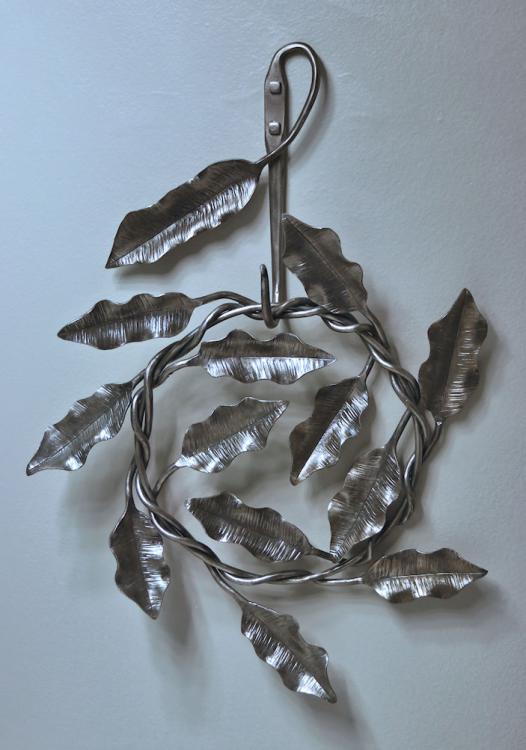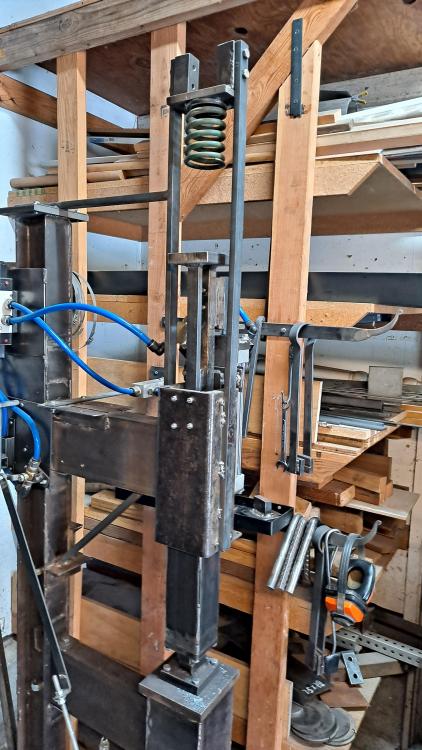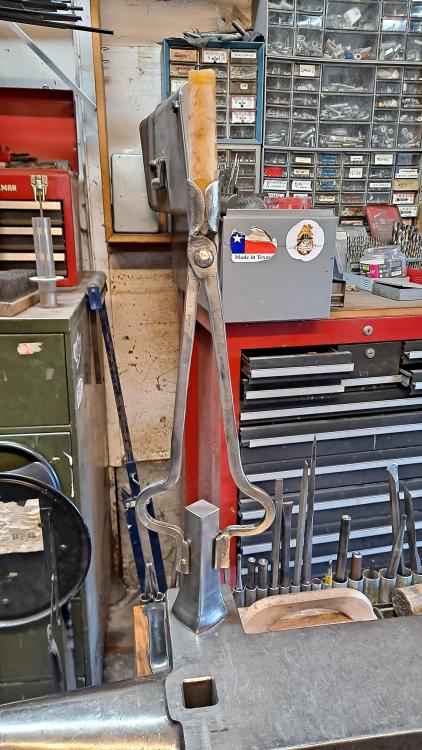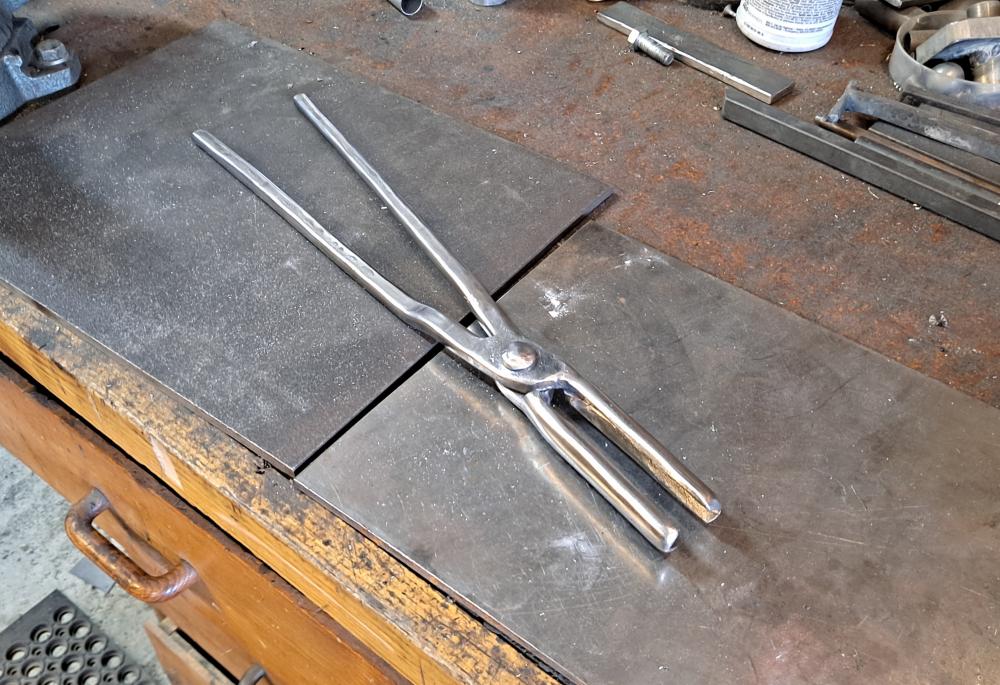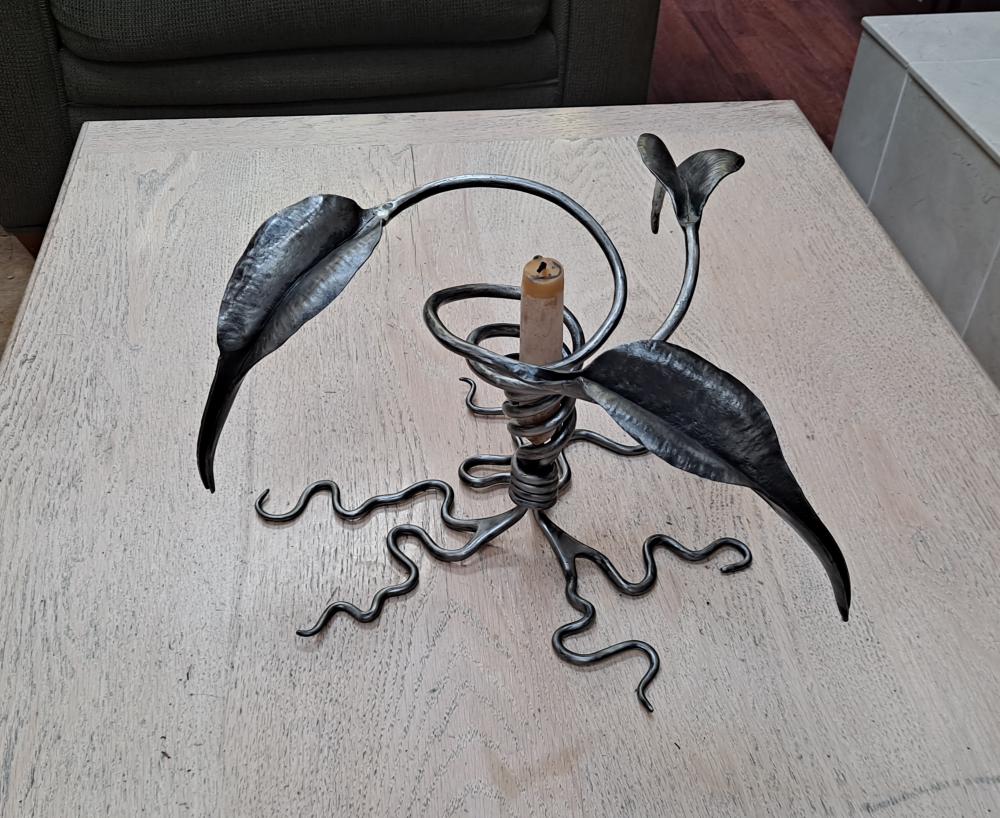
Ted Ewert
Members-
Posts
557 -
Joined
-
Last visited
Content Type
Profiles
Forums
Articles
Gallery
Downloads
Events
Everything posted by Ted Ewert
-
What did you do in the shop today?
Ted Ewert replied to Mark Ling's topic in Blacksmithing, General Discussion
Thanks Frosty. I resemble that last remark! Actually, a buddy of mine and I saw a big UFO fly above some close-by hills one night. We got a real good look at it and it wasn't any swamp gas or a weather balloon. The leaves in the candle holder were folded over, peened into a curve, then opened back up. Is that what you're referring to? -
What did you do in the shop today?
Ted Ewert replied to Mark Ling's topic in Blacksmithing, General Discussion
Looks like it's coming along nicely. I need a vise like that. Ooooo... That must be the secret underground hanger with all the UFO's and dead aliens. -
What did you do in the shop today?
Ted Ewert replied to Mark Ling's topic in Blacksmithing, General Discussion
I saw a picture of an old boxcar somewhere in Georgia covered in Franklin vines. It inspired me to make a wreath of Franklin. -
JLP Blacksmith Teaching Center.
Ted Ewert replied to jlpservicesinc's topic in Building, Designing a Shop
Never thought of twisting steel, but a great idea. Did it come with a bucket of thread dies? -
JLP Blacksmith Teaching Center.
Ted Ewert replied to jlpservicesinc's topic in Building, Designing a Shop
That's a beast. Handy though if you're plumbing in gas for the shop or making large bolts. Do you have plans for it? -
I filled my stand with concrete and it's held up just fine. It deadens any ringing and adds mass and stiffness. On a side note, I put some strong magnets on my anvil to see if they would deaden the slight ringing on the horns. They did help a bit, but tools kept sticking to them so I removed them. Now the horns are still a bit quieter. Strong magnets will magnetize any steel except mild steel. I'm wondering if the residual magnetism is dampening the ringing. It should in theory, but it's still a subjective test. BTW, hammering steel on the section of the anvil where the magnet is will induce more residual magnetism than just sticking the magnet on.
-
Mechanical to Pneumatic hammer conversion
Ted Ewert replied to Ted Ewert's topic in Power Hammers, Treadle Hammers, Olivers
Update. I finally have this hammer working just as I want it to. I shortened the stroke to 8 inches, lightened the ram to 35 lbs, and built a number of dies. I get better performance out of the 35 lb ram due to the increased velocity. It's also more controllable with my particular set-up I just added a spring bumper to cushion the top of the stroke. -
What did you do in the shop today?
Ted Ewert replied to Mark Ling's topic in Blacksmithing, General Discussion
I appreciate scroll work but it has never really grabbed me as something to make. Same thing with knives. Nevertheless, I still enjoy seeing the nice pieces turned out here. Thanks for sharing. -
I have some sheet metal on the wall directly behind my propane forge. This is more to protect the wall from scorching. What kind of forge are you planning to use?
-
What did you do in the shop today?
Ted Ewert replied to Mark Ling's topic in Blacksmithing, General Discussion
Thanks Das, I made it as sort of a joke, but turned out better than I thought. Should have made the reins shorter as it's a bit top heavy. Funny thing, the tongs turned out a lot better when I wasn't stressing about every detail. I was having fun building it instead of judging every step. JHCC, nice hanger and hook. -
What did you do in the shop today?
Ted Ewert replied to Mark Ling's topic in Blacksmithing, General Discussion
I'm thinking seriously about building a press. I've done some research, but there's nothing like having all the little details in one place. How do you like the book so far? -
What did you do in the shop today?
Ted Ewert replied to Mark Ling's topic in Blacksmithing, General Discussion
I told Lucky that if all else fails I could always turn my tongs into a candle holder. Well, here it is. Features include: sturdy upset base, movable rein for easy candle replacement and it's completely fireproof. Sits nicely on the side table of the anvil too. The smart blacksmith motif will easily fit into any shop. Great to have on hand for those annoying power outages. No shop is complete without one. -
What did you do in the shop today?
Ted Ewert replied to Mark Ling's topic in Blacksmithing, General Discussion
They're OK, and work fine, but it took me 6 hours to get them done. I guess I set my own expectations higher than my abilities. It also took a lot of 120 volt rasping to get them looking the way they do. I haven't gotten to the point where I feel confident and relaxed while making these things. It's a bigger deal in my head than in reality. I see all the imperfections but they're minor really. If all else fails, I can always weld some roots on and turn it into a candle holder. You're right. I didn't know what else to call them. I saw someone using a similar pair in a video and decided to make some. Those jaws were difficult. I used chisels, V swedges, and a piece of square stock. The profile at the end turned out slightly rectangular. A press would have made short work of it. -
What did you do in the shop today?
Ted Ewert replied to Mark Ling's topic in Blacksmithing, General Discussion
I've been practicing my blacksmithing skills lately attempting to craft a presentable set of tongs. I'm on about my sixth pair now and have figured out a new way on each to mess it up. With every error the fix requires making the other half the same. This invariably results in the removal of material. What started out as a stout pair of tongs slowly becomes a stout pair of pliers. Is a humiliated blacksmith an oxymoron? Anyway, here is what I did in the shop today. Long box jaw tongs for 5/8" square stock. -
What did you do in the shop today?
Ted Ewert replied to Mark Ling's topic in Blacksmithing, General Discussion
If I have a striker and can't find a piece of flint, is it OK to use a grinder? I've been successful using this method to ignight my shirt on several occasions. -
What did you do in the shop today?
Ted Ewert replied to Mark Ling's topic in Blacksmithing, General Discussion
Thanks! Jobtiel1, nice work on both the striker and the bag! Spring steel is not the easiest thing to move. What are you foraging for? The only foraging I do these days is in dumpsters. DHarris, Stranger things have come out of my shop. They were supposed to be roots, but they look a lot like worms. The only welding I did on it was underneath the wrap, to hold the pieces together. Otherwise it started life as three lengths of 3/4" x 3/8" bar stock. Daswolf, love the gator. -
What did you do in the shop today?
Ted Ewert replied to Mark Ling's topic in Blacksmithing, General Discussion
I made this candle holder on a whim. Getting the helix close to even was difficult. This was one of those projects where two hands weren't enough. -
What did you do in the shop today?
Ted Ewert replied to Mark Ling's topic in Blacksmithing, General Discussion
Pat, you're not bad at anything, just under practiced. Welding takes a while to get the hang of. Even then a weld will go south from time to time. You can always use the old "fill and grind" technique: fill in the holes and grind off the excess. Your tools may not be pretty at first, but if they work they're good enough. Just don't get discouraged when your first tries don't turn out like the video you saw on YouTube. Most of those guys don't show you their own scrap bin. -
My father was a mechanical engineer and owned a gear manufacturing company. He explained to me at an early age the difference between casting and forging. I've read a lot about forging and casting since then and haven't seen anything that contradicts the theory that forging realigns the grain structure in steel to make it tougher and stronger than it's casted counterpart. If you have some new information I'm all ears.
-
Milwaukee Forge begs to differ: Forging is stronger than casting. One of the main reason we choose to provide forging services is that it provides a stronger end product for our partners. According to a study performed by the Industrial & Manufacturing Engineering Department at the University of Toledo: Forged parts had a 26% higher tensile strength than the same cast parts. Forged parts had a 37% higher fatigue strength resulting in a much longer lifespan than cast parts. Cast iron only had 66% of the yield strength of forged steel, a measurement that indicates the load amount metal can hold before deforming. The forged parts had a 58% reduction in area when pulled to failure, compared to 6% reduction for cast parts. That means forge parts allow for much greater deformation before failure than cast parts. Why is this? When you melt metal, the grain size is free to expand. This creates a final product with a more random grain structure. A more random grain structure leads to deceased strength. The forging process keeps the grain structure tight and the product mechanically strong. There is also less need for expensive alloys to retain high strength. https://www.forging.org/uploaded/tinymce/media/Fatigue.pdf
-
If it isn't a very old saddle I would guess that you're looking at cast steel. Casting produces a different grain structure in steel than forging does, which makes it brittle. I would experiment with the broken one to figure out how to bend it, if possible, without breaking it. Probably lots of heat.
-
I put a small chamfer on the inside edge of the boss hole so the tongs don't act like a shear on the rivet. If you punch the hole and have a small radius it's not needed. If you drill the hole it's not a bad idea.
-
This must have turned out as everyone expected. Thomas was correct about the laws of physics. Most humans can put out about an eighth of a horsepower. That's why Tesla invented the AC motor. At least you have a frame (I assume). Just buy one piece at a time, scrounge what you can, and before long you'll have a nice press.
